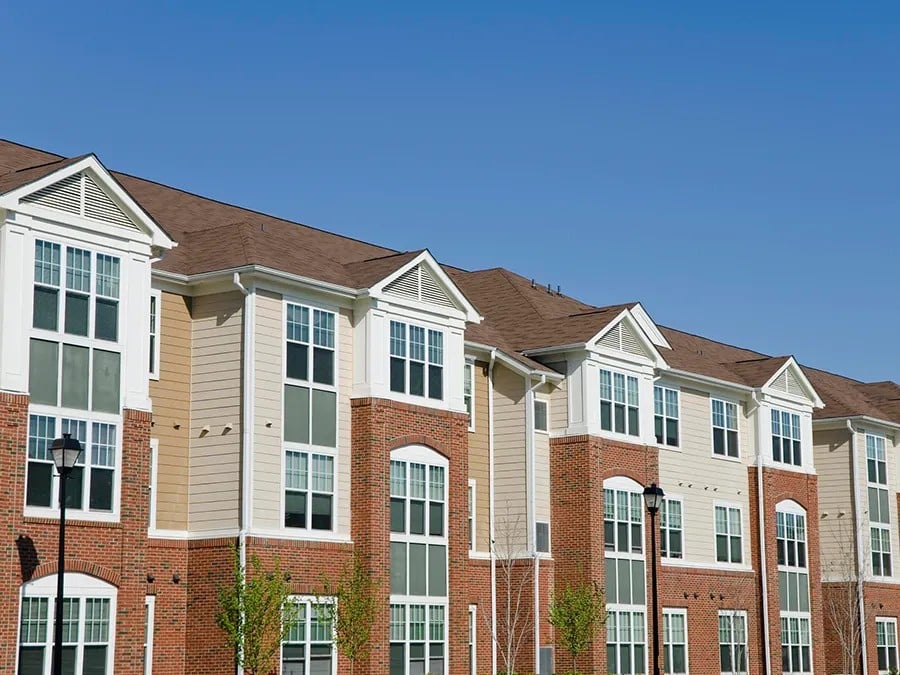Multi-Housing Roofing in the Phoenix East Valley
First Response Roofing AZ is a top choice for multifamily roofing services. We offer apartment condo
roofing and condominium roofing installation, repair and maintenance. We are happy to work with property managers to ensure that roofing services are completed at a time that is best for them and their residents.
Whether you need sloped roofing or flat roofing for a condo or apartment, we’ve got the experience needed to get the job done right. Give us a call to request an estimate for multi-unit roofing in Gilbert, Chandler, or anywhere in the entire East Valley.
Schedule a FREE Roof Inspection
- Apartment Roof Installation
- Roof Tear Off & Re-Roofing
- Shingle Roofing
- Tile Roofing
- Flat Residential Roofing
- Roof Maintenance
- Roof Repair
- Emergency Roof Tarping
- Build Up Roofing
- Condo Roof Replacement
- Storm Damage Roof Repair
- Roof Leak Sealing
- Roof Coating
- Solar Panel Roofing Prep
- Roof Tile Replacement
- TPO Roofing

Multi-Housing Roofing Company
Property managers and owners considering roof replacements for multi-family properties might feel a little overwhelmed. After all, there are so many roofing companies, roofing solutions, and quality materials to choose from. From asphalt shingles to standing seam metal roofing, the options roofing services seem endless. Fortunately, understanding the basics of each type of roofing material will help you make an informed decision.
Quick Answer:
The most popular roofing materials used on multi-family buildings tend to be asphalt shingles, metal roofs, clay tiles and wood shingles. It’s important to evaluate factors such as local weather, budget and durability when selecting the best roofing option for your multi-family building.

Get Started Now
Whether you have a residential roofing concern or a commercial roofing emergency, we’re ready to help you – safely, quickly, and affordably.
What is Multi-House Roofing?
When it comes to roofing for multi-family dwellings such as apartment buildings, condominiums, or townhomes, there are a few important factors that should be taken into consideration. Multi-family roofing is the installation of a single roof system over a large building or several connected buildings that house multiple families or individual residents, or a community of tenants. It’s essential for property owners, developers, and building managers alike to make informed decisions about the materials used for their multi-family projects in order to get the most out of their investment.
Types of Multi-Family Roofs
In the world of multi-family roofing, there are a variety of different types to consider for your property. Each type of roof has its own advantages and disadvantages, and it’s important to understand which option is best suited to meet the particular needs of your building. The most common types of multi-family roofs are flat roofs, pitched roofs (including shingle), metal roofs, and built-up roofs.
Flat Roofs
In the world of multi-family roofing, there are a variety of different types to consider for your property. Each type of roof has its own advantages and disadvantages, and it’s important to understand which option is best suited to meet the particular needs of your building. The most common types of multi-family roofs are flat roofs, pitched roofs (including shingle), metal roofs, and built-up roofs.
Pitched Roofs (Shingle)
Pitched roofs come in a variety of styles including asphalt shingle, wood shake, metal tile, or stone tile roofing. This type of roof typically increases a building’s aesthetic appeal with its attractive slope, making it the preferred choice for many condo and townhome projects. With regular maintenance, it can last up to 40 years, but depending on what material is selected, the upfront cost may be higher than with other roofing options. Additionally, because these systems often need to be replaced more frequently than flat roofing materials, they are less desirable for larger buildings.
Metal Roofs
Metal roof systems are often thought of as the most durable roofing material available as they can last up to 50 years with proper maintenance – almost double that of shingle roofs. They come in a range of colors, textures, and styles, providing a modern look to your property and help insulate against sound helping them an ideal option for apartments located in noisy areas. On the downside, metal roof systems can cost significantly more than other materials, so careful budget considerations should be made when selecting this option.
Built Up Roofs (BUR)
Built-up roof systems have been around since the late 1800s and have proven themselves time and time again as reliable commercial rooftop solutions. These types of roofs are constructed from alternating layers of tar paper coated with an asphalt-based waterproofing agent topped off with aggregate such as gravel or slate chips which helps protect against ultraviolet rays from the sun and heat loss in colder climates. BUR options must be inspected annually due to their lowslope design, which increases their vulnerability to leaks developing over time.
Next we will turn our focus specifically on flat roof systems – discussing everything you need to know before you buy into this popular type of multi-family roofing solution.
Multi-Family Roofing Materials and Installation
Multi-family roofing materials and installation come with a variety of considerations to ensure the best possible outcome for both the building’s appearance and its durability. A few of the factors to consider when assessing multi-family roofing materials and installation include material type, warranty, cost, labor requirements, and local climate conditions. It is always important to begin with a thorough roof inspection to understand whether you need a roof repair or roof replacement. A good roofing company will do free inspections to provide an accurate estimate.
One primary consideration for any roofing project is the material being used. Many popular choices include composition shingles, metal, wooden shakes and synthetic slate. Each material has its own unique characteristics which should be evaluated in terms of cost and longevity. Furthermore, many communities have local laws or regulations governing what types of roofs can be installed on multi-family buildings due to safety considerations like fire resistance.
Another factor to think about is whether or not a manufacturer’s warranty applies to the job. Generally, stronger warranties will apply if new materials are used; however, some companies also offer warranties on reroofing jobs. It is important to inquire around customer experience regarding warranty service as well as read through the fine print when available.
The cost associated with multi-family roofing installation is another very important detail to consider. Both the materials and labor costs need to be taken into account when estimating a budget for this project. First Response Roofing AZ provides free roof inspections and accurate estimates, call (480) 924-4444 today to schedule an appointment.
Frequently Asked Questions
Will Insurance cover the cost of wind and hail damage to a multi-family roof?
Contact your insurance agent or customer service department of your provider. They can provide details of your coverage and have knowledge of the type of leak or damage that is covered.
What are the common challenges associated with multi-family roofing projects?
The most common challenges associated with multi-family roofing projects include:
1. Structural integrity: Most buildings have multiple stories and multiple roofs, some at different angles that can require additional support if higher loads are added to the structure. This can prove challenging when dealing with older buildings or ones that were not originally designed to accommodate a multi-family roof.
2. Weight considerations: Multi-family roofs need to be designed according to the weight of the materials being used, as well as other elements like snow and ice. The wrong design could mean overloading a section of the roof and taking a risk of having it collapse unexpectedly.
3. Water drainage: Multi-family roofs need to be properly designed in order to ensure proper water drainage and prevent costly leaks or damages due to water gathering on the roof. Additionally, the pitch of each section should be accounted for to provide an even distribution of water across the roof surface.
4. Difficult access: Multi-family roofs typically have difficult access points due to their size and complexity. This can make repairs difficult, since workers will need to be able to move around the roof safely and quickly in order to get their job done with minimal disruption.
5. Maintenance: Maintenance is very important when it comes to any kind of multi-family roofing project, as even small problems that are left unaddressed can lead to bigger, more expensive issues down the line. Regular inspections and maintenance should be carried out in order to keep the roof functioning optimally in all conditions.
What are the different types of multi-family roofing materials available?
There are several different types of multi-family roofing materials to choose from. The most common types used for multifamily roofing projects include asphalt shingles, metal roofing, tile roofing, wood shakes, and rubber roofing.
Asphalt shingles are the most popular choice for multi-family roofing due to their cost effectiveness, durability, and range of color options. Asphalt shingle roofs can be expected to last 15-20 years or longer when properly installed and maintained.
Metal roofing is a low maintenance option that is energy efficient and can last up to 50 years or more with proper installation and periodic care. Metal roof panels come in a variety of colors, shapes and sizes, which means they can be customized to fit the look of any building.
Tile roofing is also an increasingly popular choice due to its durability and fireproof qualities. These tiles come in many colors, styles and textures, allowing them to coordinate with almost any architectural style. Although costly upfront, tile roofs often last longer than other material options. Typically lasting 40-50 years.
Wood shakes are another great option for multi-family buildings as they provide a unique, rustic look with natural beauty and charm. They require more maintenance than metal or tile roofs but may last 20-30 years if well cared for.
Finally, rubber roofing is considered by many as the most eco-friendly option for multi-family buildings because it’s made from recycled tires. Rubber roofs are highly durable, non-toxic and able to withstand extreme weather conditions without cracking or melting. Life expectancy of a rubber roof typically ranges from 20-40 years depending on its location and the environment it’s installed in.
How can I find a good roofing contractor or roofer for my multi-unit building?
Pick up the phone and give First Response Roofing AZ a call for a free inspection. Our team will get you scheduled and a crew
member will inspect the current roof, set the expectations, and provide information about the price and financing options.
Get Started Now
Whether you have a residential roofing concern or a commercial roofing emergency, we’re ready to help you – safely, quickly, and affordably.

